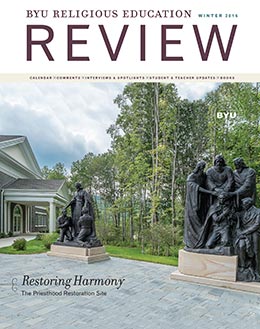Aaron Schade (aaron_schade@byu.edu) is a professor of ancient scripture at BYU.
During the spring semester of 2015, Dr. Aaron Schade and Sarah Palmer and John Harrison (BYU ancient Near Eastern studies majors) participated in the Khirbat ‘Ataruz Excavation in the Hashemite Kingdom of Jordan. Jordan is rich in cultural heritage and famous for its ancient peoples, such as the Moabites, Ammonites, and the Nabateans, along with their spectacular dwelling at Petra (and yes, of course, Indiana Jones). Based in the city of Madaba, the location of the famous Byzantine “mosaic map,” BYU participants commuted 30 minutes each morning to dig the Iron Age site of ‘Ataruz and traveled weekly on educational fieldtrips throughout the country. These trips provided a thorough exposure to the rich history and culture of Jordan and afforded exciting glimpses into the history and archaeology pertaining to the Old and New Testament worlds. Along with teams consisting of students and faculty from La Sierra, Averett, and Andrews Universities and workers from the local beni-Hamidah tribe, the participants worked to uncover city walls, rooms, and extensions of an ancient Iron Age temple (ninth century BC). It was an experience never to be forgotten.
Filled with a history of ancient battles and cultic worship, the archaeological site of ‘Ataruz is located on the ridge of Jabal Hamidah in central Jordan and is perched on the mountains overlooking the Dead Sea. It is roughly 3 km east of the Roman fortification of Machaerus, which Josephus associated with the location of John the Baptist’s beheading.
Throughout its history during the biblical period, ‘Ataruz held a place of strategic and religious importance.
Under the direction of Dr. Chang-Ho Ji of La Sierra University, the last several dig seasons at ‘Ataruz have uncovered numerous religious artifacts and structures, shedding light on the historical and religious practices described in ancient written sources. The Bible states that ‘Ataruz was built by the Israelite tribe of Gad (Num. 34:32). Centuries later, the famous Mesha Inscription (written in Moabite from the mid-ninth century BC), describes wars between King Mesha of Moab and the “men of Gad” who were still dwelling in the region and at this site. (A similar scenario is described in 2 Kings 3 from a different perspective.) While Israel was preoccupied with the Assyrians to the North, King Mesha rebelled and overtook the Israelite tribe of Gad and devoted his victory to his god. Religious structures pervade ‘Ataruz, and the site bespeaks the defensive measures put in place to protect it. Our work in the field attempted to answer some of the enigmas surrounding ‘Ataruz, including issues associated with its fortification and defense, its cultic activities, and the history of its occupation.
